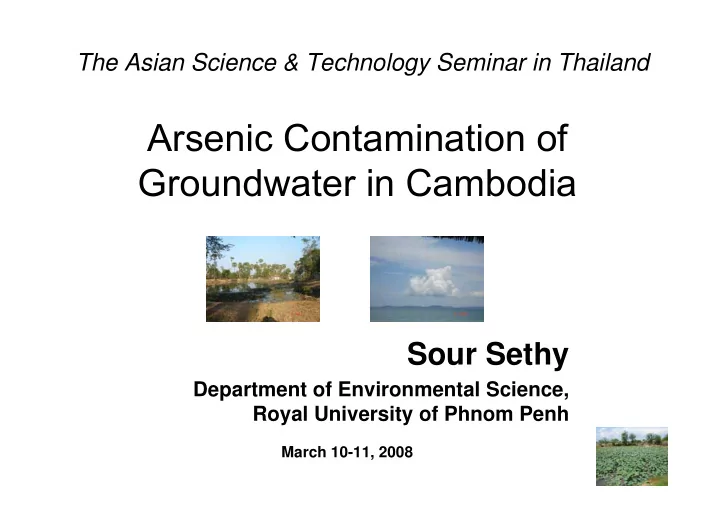

The Asian Science & Technology Seminar in Thailand Arsenic Contamination of Groundwater in Cambodia Sour Sethy Department of Environmental Science, Royal University of Phnom Penh March 10-11, 2008
Contents • Background • Arsenic Situation • Education Program • Key Lessons Learned • Conclusion • Recommendation
Background � Arsenic was detected in Cambodia in 2001 through National Drinking Water Quality Assessment. � Arsenic Inter-Ministerial Sub- Committee (AISC) established in 2002. AISC consists of 5 Ministries (MRD, MIME, MoH, MoE and MoRAM).
Background � National As Database established in 2003. � Clinical Survey was conducted in 2003. � National Drinking Water Quality Standards established in 2004. � National Testing, Painting and IEC program established in 2004.
Background � As 5 Year Strategic Action Plan developed in 2006. � Arsenicosis Case Detection and Management was carried out in 2006.
Arsenic Situation � Survey for 1607 villages showed that: � 7 provinces located along the main rivers are the most at risk. � As Occurred mainly in sediments near the rivers like Mekong, Bassac, and Tonle Sap River
Arsenic Situation
Percentage of the Distribution of Arsenic Concentration in 7 High Risk Provinces 5.40% 3.60% 1.80% 100% 7.50% 13.80% 15.60% 90% 21.90% 80% 13.10% 25.50% 47.30% 38.70% 50.20% 26.90% 70% 60% 50% 20.30% 40% 74.50% 73.10% 67.00% 30% 57.50% 55.90% 47.90% 20% 32.40% 10% 0% Kandal Prey Veng Kampong Kracheh Phnom Kampong Kampong Cham Penh Chhnang Thom As=0 0<As<=50 As>50
Arsenic Situation � Approximately 2.25 million persons live in areas the most affected by arsenic. � 139 families with a total 309 people identified with suspected symptom: � Leukomelanosis Nodular Keartosis � (rain-drop pigmentation on skin)
Education Program • Developed IEC materials – Poster, Leaflet – Media ‗ Arsenic song
Education Program � Population were Informed about arsenic: � 35,645 Families were educated about the danger of arsenic. � 1,356 School teachers and 45,064 school children in 3 provinces were provided with education.
Education Program ☺ Testing and Painting Program • A total of 24,683 tube wells tested across the country-29% has proven to have As level higher than National Standard (50ppb). � Out of the above total, 20,427 tube wells tested in 7 high risk provinces - 35% have As level greater than 50ppb. � 1,056 tube wells in school were tested - 6.5% has As >50 ppb. � 201 tube wells tested in health care centre - 7% has As > 50ppb.
Arsenic Mitigation Program � Alternative Sources Rain Water Collection System Treatment Options
Arsenic Mitigation Program • Families beneficiaries: � 150 families were supported with shallow wells. � 5,000 families were supported with CWPs � 300 families were supported with traditional rain water jars � 363 families supported with rain water tanks. � 1,000 families used water facilities through community piped water systems.
Key Lessons Learned � Lack of budget for awareness raising and provision of alternate safe water sources along with monitoring and surveillance. � Lack of government ownership. � Database management is need to be improved.
Key Lessons Learned � Private/public partnerships in the supply of arsenic- safe water should be promoted. � Communication on arsenic contamination of wells seems to be effective in terms of discouraging people from drinking arsenic-contaminated water. However, people may turn to use unsafe surface water which has high biological contamination. It is therefore critical to provide hygiene education and at the same time promote alternative safe water technology such as household filters, rainwater harvesting and community piped water.
Conclusion • The most of highly As affected contamination is: – Kandal Province (47% of tested wells) while Prey Veng (16%) and Kampong Cham (14%) were found As>50 ppb, • Only 0.5% of open wells are contaminated, and generally at lower concentrations (maximum recorded arsenic value in an open well is 75 µg/L).
Recommendation • Need to improve coordination and collaboration between line Ministries and NGOs; • Increase involvement at each stage of implementation of the concerned ministries, responsibility, accountability, and ownership; • Strengthening capacity building to governmental staff at all levels; • Improvement database management and information sharing with all stakeholders;
Recommendation • Strengthening the collaboration with MoEYS, university and institution- School- based Arsenic education, Innovative technology on Arsenic removal, ground water quality study; • Improve the capacity of national laboratory; • Need to continue to monitor water quality, • Need to continue to study the reason of high arsenic contamination along the Mekong, Bassac and Tonle Sap river.
Thank you very much !!! Email: ssethy@yahoo.com
References • MRD, 2006: Powerpoint presentation in the AISC meeting in August 2006. • F., David, 2004: Situation Analysis: Arsenic Situation Analysis: Arsenic Contamination of Groundwater in Cambodia supported Contamination of Groundwater in Cambodia supported by UNICEF. by UNICEF. • Sophary, 2007: Power point presentation of Arsenic contamination in Cambodia.
Recommend
More recommend